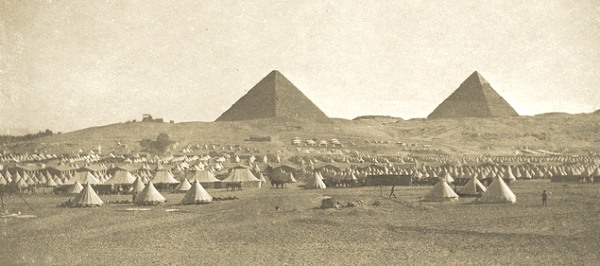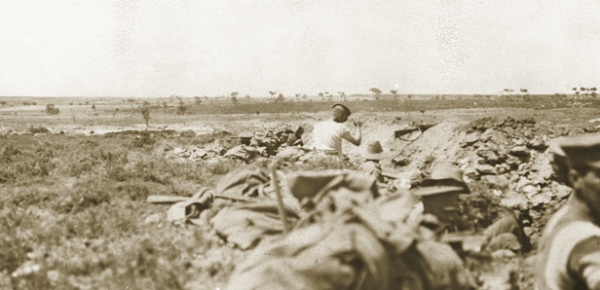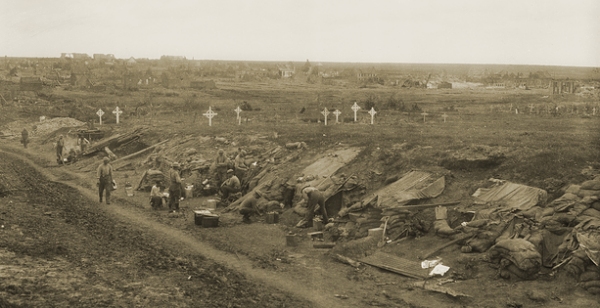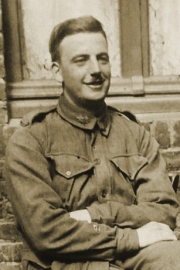Melbourne Tram Museum
- Follow Melbourne Tram Museum on Twitter
- Follow Melbourne Tram Museum on Facebook
- Follow Melbourne Tram Museum on Instagram
- Follow Melbourne Tram Museum on Pinterest
- Follow Melbourne Tram Museum on Tumblr
- Subscribe to Melbourne Tram Museum's RSS feed
- Email Melbourne Tram Museum
Tramway ANZAC: Colin Graham Forrest
A Scotsman proud to serve with Australians
Scottish-born Colin Graham Forrest was a clerk with the North Melbourne Electric Tramways & Lighting Company (NMETL) when he enlisted in 1914. He served at the Gallipoli landing and with distinction on the Western Front, progressing through the ranks, to eventually be commissioned as a Lieutenant. And then, once he returned to Melbourne, Colin actively assisted in the repatriation effort, finding employment for veterans.
Colin grew up in Leith, a major port district that serves the Scottish capital of Edinburgh. Born on 6 May 1893, he was the second of three brothers. His parents, Thomas, a marine engineer, and Margaret were originally from Dunfermline, a town to the northwest of Edinburgh.
After leaving school, Colin was apprenticed as a clerk at Peter Dowie & Co, produce merchants of Leith, for three and a half years. Then in 1913, he emigrated to Australia, arriving in Melbourne in December and obtaining employment as a casual clerk at NMETL.
He was popular and well-liked at NMETL, the company noting in its acknowledgement of enlisted staff in the local newspaper his “courteous and obliging manner”.
Just six days after war began, recruiting offices opened on 10 August 1914 at army barracks around Australia. Colin wasted little time, enlisting on 18 August 1914 as a private in the 5th Battalion. His enlistment form stated that he was one year older than his actual age – he was definitely older than the minimum age for recruits, so perhaps this was simply a clerical error.
He already had some military experience in Scotland – four years in the 9th Battalion (Highlanders), Royal Scots (Territorial Force), serving from 1908 to 1912. The Territorial Force (TF) was a volunteer auxiliary for the British Army, created for the purpose of home defence if a large part of the British Army was to be deployed overseas in the event of war. Most regiments – with a few notable exceptions – had TF units.
The 5th Battalion was raised from Victorian men, mostly Melbourne residents, many of whom had served in the militia with the Victorian Scottish Regiment. The battalion’s ranks were filled after only two weeks of recruiting. Two months of basic training followed at Broadmeadows Camp, on the outskirts of Melbourne, while musketry training was performed at the Williamstown Rifle Range.

5th Battalion disembarking from HMAT A3 Orvieto at Alexandria, Egypt, 2 December 1914.- Photograph courtesy of Australian War Memorial (H02030).
Action in Gallipoli
The 5th Battalion embarked from Melbourne on 21 October 1914 on HMAT A3 Orvieto, arriving in Egypt on 2 December 1914. En route at Colombo the Orvieto embarked prisoners of war from the German cruiser SMS Emden, which had been sunk by one of the convoy’s escorts, HMAS Sydney, in the Battle of Cocos on 9 November 1914.
The battalion disembarked in Alexandria, proceeding to Mena Camp, about 10 miles outside Cairo. Mena Camp was one of three training camps in Egypt used by the Australian Imperial Force.

Mena military camp, Egypt, looking towards the Pyramids, 28 February 1915.- Photograph courtesy of Australian War Memorial (H04206).
The battalion participated in the ANZAC landing at Gallipoli on 25 April 1915, as part of the second wave.
On 1 May 1915 Colin was promoted to a Lance Corporal. A few days later the 2nd Brigade, which included the 5th Battalion, was transferred to Cape Helles, to assist in the attack on the village of Krithia. According to the Australian War Memorial, little ground was captured in the attack and the brigade lost almost a third of its strength. In that action Colin suffered a gunshot wound in his right leg. Evacuated to Malta and then to hospital in England, he did not rejoin his unit until December, just prior to the evacuation from Gallipoli back to Egypt.

A trench dug by the 2nd Australian Brigade at Cape Helles, Gallipoli Peninsula, 9 May 1915.- Photograph courtesy of Australian War Memorial (G00966).
The Western Front
Colin transferred to the newly formed 57th Battalion in February 1916, and shortly afterwards was promoted to Sergeant. Raised in Egypt, the 57th was comprised of Gallipoli veterans, like Colin, and fresh reinforcements from Australia. Within three months Colin was promoted again to Company Quartermaster Sergeant (CQMS) before the battalion embarked for the Western Front.
The Somme offensive, an ultimately futile campaign characterised by appalling casualties for little gain, spanned the period from July until November 1916. Arriving in France in June 1916, the battalion’s first major action was the disastrous Battle of Fromelles on 19-20 July. With only a supporting role the battalion’s casualties were relatively light in comparison with those of other battalions.
After a temporary 12-day appointment to Regimental Quartermaster Sergeant (RQMS), Colin reverted briefly to CQMS before being commissioned as a 2nd Lieutenant in September 1916. He was further promoted to Lieutenant as from 23 January 1917, although this was not confirmed until some months later.
Colin’s leadership and courage in a minor night action in February 1917, were recognised in the following recommendation from the commander of 57th Battalion, Lieutenant Colonel James Campbell Stewart.
East of Guedecourt on the night of the 15/16th February 1917, 2nd Lieut FORREST showed great courage in the face of the enemy. In a minor operation carried out by the Battalion he was in charge of a bombing party of 25 which he hand[l]ed with great skill. After a violent bomb fight lasting for an hour our leading team gave way. 2nd Lieut FORREST and Sergeant [Peter Benjamin] MALONE then led the party, bombing the enemy back and establishing a block on our objective which was held for 27 hours during which time an enemy counterattack was repulsed. Seven of the enemy were killed on our side of the block and we were able to connect up a valuable piece of trench. 2nd Lieut FORREST's work during the operation was worthy of the highest praise.
Colin was awarded a Military Cross and Sergeant Malone a Distinguished Conduct Medal resulting from this action.
On 11 May 1917 during the Second Battle of Bullecourt, the unit was subject to heavy artillery bombardment. Colin suffered a serious shrapnel injury to his face, resulting in temporary blindness in his left eye, and was subsequently evacuated to England. After two weeks in hospital his sight began to recover, and in June he was declared fit for service.

Troops billeted in a sunken road near Bullecourt, France, during the fighting of Australian troops in that sector, 19 May 1917.- Photograph courtesy of Australian War Memorial (E02021).
Colin returned to his unit in France on 20 July 1917 and subsequently was detached to 15th Infantry Brigade Headquarters, where the brigade commander was Harold Edward (Pompey) Elliott. While his service record notes only one detachment, a series of letters from Colin to his mother describes several separate periods at Brigade HQ over the latter half of 1917. His tasks included organising the supply of ammunition to the entire Brigade and supervising the training for Grenadiers (weapons familiarisation and tactics for combat with hand and rifle grenades) and Musketry (rifle skills with the standard bolt-action service rifle, the Short Magazine Lee Enfield.).
During a period of leave in England, Colin was presented with his Military Cross by King George V at Buckingham Palace on 9 January 1918. After his leave, Colin returned to his unit in France.
In his letters written over the period 1917-18, Colin expressed his pride in serving with Australians. In one letter dated 25 April 1918, he is clearly delighted at the battalion’s progress in the Battle of Villers Bretonneux, turning the last major German offensive of the war.
He arrived back in Australia on 30 April 1919 on the Kashmir, and his military appointment was terminated on 21 September 1919.
Colin’s two brothers also played active roles during the war. His older brother, John Graham Gillespie Forrest, was a Gunner in the Royal Garrison Artillery, while his younger brother, Thomas Johnstone Forrest, was a merchant seaman. Both survived the war.
Repatriation: a mammoth task
At the end of World War I, the repatriation of more than 160,000 individuals to Australia was a massive logistical undertaking. Not only bringing them home, but also assisting their return to civilian life.
According to the Department of Veterans’ Affairs, by war’s end, some 93,000 men had already returned to Australia, of which almost 75,000 were “unfit for service”, leaving over 130,000 service personnel still overseas, including:
- 95,000 serving in France
- 6,000 in Britain, in hospitals, convalescing, in reinforcement depots or working on staff
- 30,000 in the Middle East and other theatres of war.
In addition, thousands of men had married while stationed overseas – transport for wives and children was also needed.
The repatriation process involved three stages:
- bringing people back to Australia
- demobilisation, or reducing the military to peacetime strength
- reinstating service personnel into civilian life.
Due to a lack of suitable ships, together with the need for special care of sick and wounded personnel, criteria were established for determining priorities for transporting back to Australia, based on:
- length of service, with those who served at Gallipoli to return first
- family responsibilities
- assured employment.
Servicemen who prior to enlistment worked for Melbourne's municipal tramway trusts were guaranteed a position on their return, if they had not resigned before enlisting. However private companies – such as the Melbourne Tramway and Omnibus Company (MTOC) and NMETL – were under no such obligation. MTOC, a good corporate citizen, reinstated ex-employees, as did its replacement, the interim Tramway Board.
The Repatriation Department (now known as the Department of Veterans’ Affairs) was created by the Australian Government in 1918, to assist with returning veterans to civilian life. Support provided by the Department encompassed vocational programs to develop skills, finding employment, delivering medical services, and providing financial assistance for veterans, dependants and widows via pensions and loans.
Colin was clearly not keen to return to an ordinary clerical position after his war experiences. On his demobilisation form he stated that there was no promise of work from his previous employer and that his proposed occupation was commercial or plantation work in New Guinea, “or other island”.
Rather than heading for the Pacific islands, Colin joined the Repatriation Department as an Employment Scout. As such, he was actively involved in finding employment for veterans, including those disabled in the course of their service. Again, he was highly regarded in his workplace – a note on his repatriation file stated that he was extremely popular in the Employment Section within the Victorian State Office.
He was living at 50 Acland Street, St Kilda.
Colin never reached the Pacific islands. Just after midnight on 19 February 1920, Colin was travelling southwards down St Kilda Road by motorcycle and near the Domain Road intersection appeared to lose control, colliding with a tree and fracturing his skull. He was taken to the Melbourne Hospital (now the Royal Melbourne Hospital), but died three days later. It was less than a year after he returned to Melbourne and he was only 26 years old.
In the subsequent inquest, the coroner found that Colin’s death was the result of injuries received in an accidental fall from his motorcycle.
Colin was granted a semi-military funeral, with the Defence Department supplying a bugler to sound the Last Post as well as a gun carriage to carry the coffin to Coburg Cemetery, where he was buried. His unit commanders, Brigadier General (Pompey) Elliott and Brigadier General Stewart, attended the funeral.
Colin was survived by his mother and two brothers.
Bibliography
The Age (1920), About People, 24 February 1920
Australian War Memorial (1917), Honours and Awards (Recommendations) – Colin Graham Forrest
Australian War Memorial, 5th Australian Infantry Battalion
Australian War Memorial, 57th Australian Infantry Battalion
Department of Veterans’ Affairs, (2020), Repatriation of Australians in World War I
C.G. Forrest (1917-18), Letters – October 1917 to April 1918, in the collection of the Australian War Memorial, AWM2020.7.39
Flemington Spectator (1915), N.M.E.T. and L.C. Ltd Roll of Honour, 10 June 1915.
National Archives of Australia (1914-1918), Colin Graham Forrest – Service Record
National Archives of Australia (1919-1920), Colin Graham Forrest – Repatriation Record
